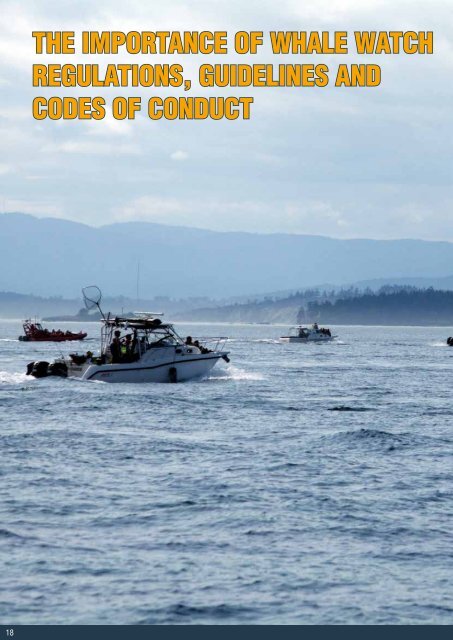Responsible Whale Watching
1gkqDcLwd
1gkqDcLwd
You also want an ePaper? Increase the reach of your titles
YUMPU automatically turns print PDFs into web optimized ePapers that Google loves.
THE IMPORTANCE OF WHALE WATCH<br />
REGULATIONS, GUIDELINES AND<br />
CODES OF CONDUCT<br />
THE IMPORTANCE OF WHALE WATCH REGULATIONS,<br />
GUIDELINES AND CODES OF CONDUCT<br />
The rapid growth of whale watching in recent years has led to a host of practical<br />
problems in many regions, including over-crowding; vessels approaching too<br />
closely or remaining too long; or more serious problems such as chasing or even<br />
colliding with watched cetaceans. In response, many countries have produced<br />
formal regulations or national guidelines, outlining minimum requirements for<br />
individuals or vessels operating in the vicinity of cetaceans.<br />
Ideally, regulations should draw upon best practice globally and consider relevant<br />
research findings. They should be both sensible and precautionary, recognizing<br />
the need to combine an enjoyable viewing experience with safety and welfare<br />
considerations for both viewers and cetaceans. Formal regulations should include<br />
provisions for monitoring and enforcement, although this can be sadly lacking in<br />
some regions.<br />
The aim, of course, should be to secure<br />
well-crafted regulations (accompanied<br />
by adequate monitoring and<br />
enforcement) for each region,<br />
however, where these are absent,<br />
voluntary guidelines or codes<br />
of conduct can be very helpful.<br />
Often these are drafted at local or<br />
regional level. WDC has assisted<br />
in the development of regulations<br />
and guidelines around the world;<br />
however, for regions where these are<br />
not yet available, we have produced the<br />
following simple code of conduct.<br />
A<br />
200 m<br />
100 m<br />
B<br />
■■<br />
■■<br />
■■<br />
■■<br />
■■<br />
■■<br />
■■<br />
REMEMBER to allow the whales and dolphins in the vicinity to decide what<br />
happens<br />
KEEP your distance! Never go closer than 100m (200m if another boat is<br />
present)<br />
MAINTAIN a steady direction and slow ‘no wake’ speed<br />
NEVER approach whales and dolphins head-on to or move between, scatter or<br />
separate individuals. If unsure of their movements, simply stop and put the<br />
engine into neutral<br />
IF whales or dolphins approach your boat or bow-ride, maintain a slow speed<br />
and course until clear. <strong>Whale</strong>s and dolphins should never be chased or harassed<br />
in an attempt to make them bow-ride<br />
SPECIAL care must be taken with mothers and young, and around whales<br />
that are feeding, resting, breeding or socially active, as they are particularly<br />
sensitive to disturbance<br />
NEVER try to swim with or touch whales and dolphins, for your safety and<br />
theirs<br />
© Ulla Christina Ludewig<br />
18 19


